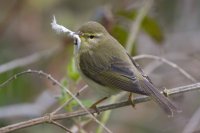Does the early bird catch the caterpillar?
20 Nov 2017 | No. 2017-37
The time that birds decide to breed has a strong impact upon the likely success of raising their young to independence. Pairs of birds will generally time egg laying to maximise the availability of food for their chicks. However, one of the strongest impacts of climate change so far has been to alter the timing of spring. In response to milder temperatures, flowers and insects are all appearing earlier than they used to. Whilst many songbirds are also nesting earlier in warmer springs, conservationists have become concerned that they are nevertheless struggling to match their timing of breeding to their main insect prey, which could be driving population declines.
To test this, the BTO, in collaboration with The Woodland Trust, Rothamsted Research, Butterfly Conservation and the Centre for Ecology & Hydrology (CEH), have collated some of the most comprehensive long-term data on the timing of spring from across the UK. They have related changes in the timing of leaf and flower emergence as well as aphid, butterfly and moth emergence, to changes in the timing of egg-laying, tracked by the BTO/JNCC Nest Record Scheme. As expected, in warmer springs, birds do tend to breed later than normal relative to the timing of spring, and the most sensitive species to changes in timing, such as Willow Warbler and Linnet are suffering the greatest population declines. However, by using data from the BTO/JNCC ringing scheme to monitor changes in the number of fledglings produced by each species per year, the study’s authors found no evidence that these mismatched species were also suffering a long-term decline in breeding success. This suggests that the population declines observed in many British songbirds are not directly caused by the effect of mismatch on breeding success.
Lead author, Sam Franks, a research ecologist with the BTO said "These results significantly increase our understanding of the specific ways in which climate change can impact bird populations. Despite a widely held belief that changes in the timing of spring are likely to be one of the factors underlying population declines, because of long-term reductions in breeding success, we found that this is unlikely to be the case for these birds. It could be that breeding later than normal in warmer springs instead results in the poorer survival of either adults or fledglings, or alternatively, the species which breed late in warm springs are constrained by other environmental pressures which are actually responsible for their population decline.”
The BTO’s Director of Science, James Pearce-Higgins, who is also an author of the study, said “The heroic efforts of thousands of volunteers recording information on birds, insects and plants provides us with the long-term data required to understand the impacts of climate change upon bird populations. Whilst milder winters have probably boosted some of our resident populations, some of our declining long-distance migrant species have not benefited in the same way. Whilst they may not be suffering from changes in the timing of spring in the way we previously thought, we still need ongoing work to understand their causes of decline.”
Notes to editors
1. This work was funded by Natural Environment Research Council (grant number NE/J02080X/1); Joint Nature Conservation Committee; Biotechnology and Biological Sciences Research Council; Lawes Agricultural Trust; BTO; Butterfly Conservation; Centre for Ecology and Hydrology (CEH); Woodland Trust
2. The paper has been published in the journal Global Change Biology as Franks, S.E., Pearce-Higgins, J.W., Atkinson, S., Bell, J.R., Botham, M.S., Brereton, T.M., Harrington, R. & Leech, D.I. (2017) The sensitivity of breeding songbirds to changes in seasonal timing is linked to population change but cannot be directly attributed to the effects of trophic asynchrony on productivity. Global Change Biology DOI: 10.1111/gcb.13960.
3. The Nest Record and Ringing Schemes are funded by a joint partnership between the BTO and the Joint Nature Conservation Committee (JNCC), on behalf of the country agencies (Natural England, Scottish National Heritage, Natural Resources Wales, and Northern Ireland’s Department of Agriculture, Environment and Rural Affairs) The Ringing Scheme is also partly funded by the ringers themselves.
4. The Rothamsted Insect Survey (RIS) is a National Capability strategically funded by the Biotechnology and Biological Sciences Research Council and supported by the Lawes Agricultural Trust.
5. The UK Butterfly Monitoring Scheme is a joint partnership between Butterfly Conservation, the Centre for Ecology & Hydrology (CEH), the BTO and JNCC (on behalf of the country agencies).
6. The UK Phenology Network (Nature’s Calendar) is a collaborative project between the Woodland Trust and CEH.
7. The BTO is the UK's leading bird research charity. A growing membership and up to 60,000 volunteer birdwatchers contribute to the BTO's surveys, collecting information that underpins conservation action in the UK. The BTO maintains a staff of 100 at its offices in Thetford, Stirling, Bangor (Wales) and Bangor (Northern Ireland), who analyse and publicise the results of surveys and projects. The BTO's work is funded by BTO supporters, government, trusts, industry and conservation organisations.







Share this page